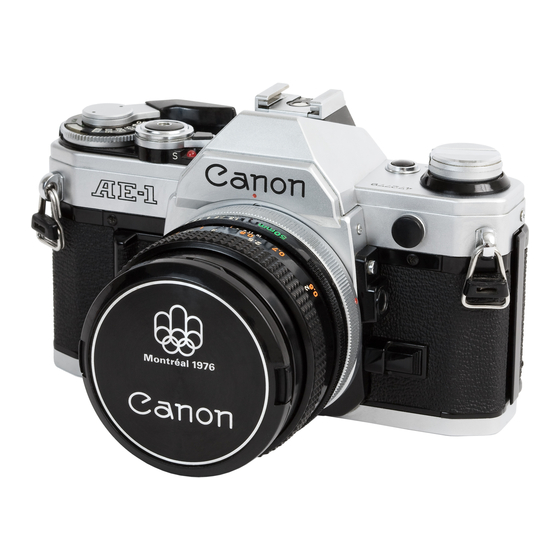Canon AE-1 Podręcznik
Przeglądaj online lub pobierz pdf Podręcznik dla Aparat cyfrowy Canon AE-1. Canon AE-1 42 stron.
Również dla Canon AE-1: Pierwsze kroki (2 strony), Instrukcja obsługi (22 strony), Podręcznik procedur instalacji (48 strony), Podręcznik (12 strony), Instrukcja obsługi (22 strony)

It revolutionized many of the concepts for future camera designs especially in the field of
electronic applications and mass produced technique with a lower cost of production with the
use of plastic injection molding, resulting in simpler assembly of parts. It also popularized and
made devices like Power Winder and electronic Speedlites a household name in the consumer
market. The camera was controlled entirely by electronics precision rather than by mechanical
functions - and depends solely on battery power for all of its functions. Despite defying the
mainstream camera design concept in the '70s, the AE-1 came through well and attained a
huge during its availability years. This was very much due to Canon's efforts in promoting the
camera - it offers very precise and stable timing of shutter speeds, which was also extended to
other areas like auto flash-synchronization speed when any dedicated Canon electronic
Speedlites is used. Although the technologies employed within the AE-1 looked very simple
when compared with today's modern SLR cameras, it has to be remembered that during its
era, the market was still dominated largely by those heavy, mechanically-controlled type of
cameras. Canon used these points to enhance the advantages of electronic applications in
camera designs - where in many areas, electronic cameras do offer much more precise timings
and other features that can never be matched by mechanical technologies.
However, the AE-1 was not in anyway a professional-grade SLR as compared to the Canon F-
1. It was generally regarded as a classic and top amateur SLR model due to the impact it has
created with its then innovative concept that went on to influence other future camera designs,
both Canon and other makes, of the industry as a whole. The camera was eventually replaced
by a newer model with added features, the AE-1 Program in 1981, following on the success of
Canon's semi-pro and top-of-the-line A-series camera, the multi-mode Canon A-1, which
made its debut in 1978.
The Canon AE-1 was the first 35mm SLR
camera to be controlled solely via a built-in
Central Processing Unit (CPU) and made
SLR photography available to beginners and
amateurs at a reasonable prices - with a record
of over 5 million units been sold worldwide,
the success of which firmly established Canon
as the leader in camera innovations.
